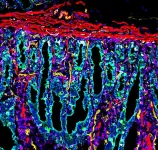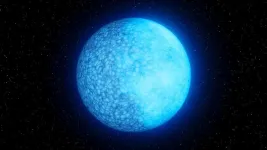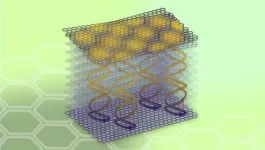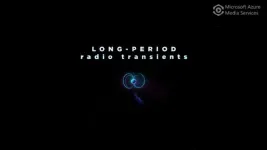(Press-News.org) COLUMBUS, Ohio – Immune system changes in the pregnant body that protect the fetus appear to extend to the brain, where a decrease in immune cells late in gestation may factor into the onset of maternal behavior, new research in rats suggests.
In adult female rats that had never given birth – which typically don’t like being around babies – depletion of these cells sped up their care for rat newborns that were placed in their cage.
The loss of these cells, called microglia, and the related uptick in motherly attentiveness were also associated with changes to neuron activity in several regions of the rat brain, suggesting shifts in immune function have a role in regulating maternal behavior.
Microglia are well-known for their link to brain injury and disease because of their protective activities under those circumstances, and for helping enable brain development. But these findings suggest they have another job entirely in the adult brain.
“Our data shows that microglia are probably also really important for plasticity in the adult brain – its ability to adapt to all kinds of changes – and contribute to normal behavioral function,” said co-senior author Kathryn Lenz, associate professor of psychology at The Ohio State University.
The findings also suggest that feeling maternal is much more than just a hormonal response.
“The standard way of thinking up to now about mothers is that hormones are the primary drivers of maternal care. But this really draws attention to the importance of immune changes to maternal behavior,” said co-senior author Benedetta Leuner, associate professor of psychology at Ohio State. “These data are novel and potentially paradigm-shifting.”
The research was published recently in the journal Neuropsychopharmacology.
Lenz and Leuner reported in previous work in rats that microglia in the brain decrease late in pregnancy. In this study, they set out to figure out why.
“More is known about how the immune system changes to support a healthy pregnancy. One of the key functions is a shift in the immune system in order to tolerate the fetus, which is a non-self entity,” Lenz said. “But honestly, very little is known about what’s happening in the brain’s immune system during and after pregnancy.”
Though rats that haven’t given birth tend to dislike babies, they can be gradually coaxed into caring for rat pups through a process of repeated exposure. For this study, the researchers tested whether loss of microglia would make a difference in how non-mother rats behaved toward foster pups.
The team gave non-mother female rats either two doses of a drug that depletes microglia or, for control animals, a sham substance that doesn’t affect cells. Once microglia levels had decreased by about 75%, pups were placed in the non-mothers’ cages, and researchers monitored the adult rats’ behavior toward the newborns. Results showed that compared to controls, the rats with depleted microglia were fully sensitized to maternal behavior significantly faster.
“This manipulation of microglial depletion – making the immune environment of the non-mother brain look like the immune environment of the maternal brain – led to behaviors that were different from the non-treated animals,” Leuner said. “And even on the days before they met the criteria for displaying maternal behavior, they started approaching the pups and were sniffing and licking them more.”
Researchers then screened the rats’ brains for a protein marker of where neuron activation had increased or decreased over time. Overall, the patterns of activation were significantly different between controls and rats with depleted microglia.
A few affected brain regions in rats with depleted microglia stood out for their potential connection to maternal behavior: Increased neural activity was found in the prefrontal cortex, important for executive functioning – being able to meet goals, stay focused and display self-control – and decreased neural activity was evident in two regions that are part of aversion circuits.
Though the accelerated onset of maternal behavior was clearly linked to microglia depletion, there is still more to learn about that mechanism, as well as the changes in neural activity patterns – did the loss of microglia drive widespread alterations to neuronal activation, or did neurons in specific brain regions respond to the rats’ uncharacteristic behavior changes?
And finally, do microglia functions differ according to sex? Up until fairly recently, most microglia studies were done in male animals – so finding this connection between prominent immune cells and female reproduction opens the door to a whole new area of investigation.
“Learning about microglia function in the life history of a female adds real complexity to our understanding of what these cells do,” Lenz said. “That’s incredibly important.”
Additional study co-authors were first author Courtney Dye and Dominic Franceschelli, both of Ohio State.
This work was supported by the National Science Foundation, the National Institute of Mental Health and the National Institute of Neurological Disorders and Stroke.
#
Contacts:
Kathryn Lenz, Lenz.56@osu.edu
Benedetta Leuner, Leuner.1@osu.edu
Written by Emily Caldwell, Caldwell.151@osu.edu
END
Early in pregnancy, something strange happens in the uterus: Cells from the fetal side of the developing placenta invade the uterine endometrium and work with the mother’s immune system to remodel the arteries.
“When I first read about it, I thought, ‘This is so bizarre,’” said Stanford Medicine pathologist Michael Angelo, MD, PhD.
Humans’ immune systems usually attack unfamiliar cells, which would theoretically pose a problem for a developing pregnancy. But on the mother’s side of the growing placenta, the arteries incorporate cells that genetically match the embryo, just one of ...
When you think about your ideal neighborhood, perhaps you think of tree-lined streets or a close-knit community of people who help each other. You probably don’t think about your digestive system.
But maybe you should. According to a team of scientists led by researchers at Stanford Medicine, there are indeed “neighborhoods” of different cell types cooperating to digest your food and protect you from infection, among other things — and a new, ultra-high-resolution map of these neighborhoods proves your intestine is both functionally impressive and visually striking.
Just like human neighborhoods, ...
The incidences of teen suicidality including self-harm, suicidal ideation, and suicide attempts increased nationally between 2016 and 2021; were at seasonal high peaks in April and October; and were at their lowest when schools were shut down during the COVID-19 pandemic, according to research at UTHealth Houston.
The study was published this month in JAMA Network Open. It was authored by Youngran Kim, PhD, assistant professor in the Department of Management, Policy, and Community Health at UTHealth Houston School of Public Health; Scott D. Lane, PhD, professor and vice chair for research in the Louis A. Faillace, MD, Department of Psychiatry and Behavioral ...
NASA has awarded funding for three science teams to conduct citizen science investigations as a total solar eclipse sweeps across North America on April 8, 2024. In these experiments, volunteers will help study the Sun and its ethereal outer atmosphere, called the corona, which is revealed when the Moon completely covers the Sun’s bright disk.
“During next year’s total eclipse, hundreds of volunteers will capture images of the Sun and its corona to help answer real science question about our star and how it affects us,” said program scientist and eclipse lead at NASA Headquarters, ...
About The Study: This study found that major U.S. cities with higher populations of Black individuals are more likely to be affected by mass shooting events, suggesting that structural racism may have a role in their incidence. Public health initiatives aiming to prevent mass shooting events should target factors associated with structural racism to address gun violence.
Authors: Michael Ghio, M.D., of Tulane University in New Orleans, is the corresponding author.
To access the embargoed study: Visit our For The Media website at this link https://media.jamanetwork.com/
(doi:10.1001/jamasurg.2023.2846)
Editor’s ...
About The Study: The findings of this study of 73,000 emergency department visits and hospitalizations for suicidality indicated the presence of seasonal patterns and an observed unexpected decrease in suicidality among children and adolescents after COVID-19–related school closures in March 2020, which suggest a potential association between suicidality and the school calendar.
Authors: Scott D. Lane, Ph.D., of the University of Texas Health Science Center at Houston, is the corresponding author.
To access the embargoed study: Visit ...
In a first for white dwarfs, the burnt-out cores of dead stars, astronomers have discovered that at least one member of this cosmic family is two faced. One side of the white dwarf is composed of hydrogen, while the other is made up of helium.
“The surface of the white dwarf completely changes from one side to the other,” says Ilaria Caiazzo, a postdoctoral scholar at Caltech who leads a new study on the findings in the journal Nature. “When I show the observations to people, they are blown away.”
White dwarfs are the scalding remains of stars that were once like our sun. As the ...
FROM: James Urton
University of Washington
206-543-2580
jurton@uw.edu
(Note: researcher contact information at the end)
Embargoed by Nature
For public release at 11 a.m. Eastern Time (8 a.m. Pacific Time; 4 p.m. British Summer Time) on Wednesday, July 19, 2023
Researchers put a new twist on graphite
For decades, scientists have been probing the potential of two-dimensional materials to transform our world. 2D materials are only a single layer of atoms thick. Within them, subatomic particles like electrons can only move in two dimensions. This simple restriction can trigger unusual electron behavior, ...
In our modern era of larger, more destructive, and longer-lasting fires—called the Pyrocene—plants and animals are evolving quickly to survive. By synthesizing the wide body of research about rapid animal evolution in response to fire in a review publishing in Trends in Ecology & Evolution on July 19, a multidisciplinary team of ecology experts hopes to leverage what we already know to help foster evolution-informed conservation plans. In this way, they suggest, we can try to harness the ways in which fire impacts animals to protect vulnerable species—working with evolution instead of against it.
In response to climate change and changes in land use, ...
An international team led by astronomers from the Curtin University node of the International Centre for Radio Astronomy Research (ICRAR) has discovered a new type of stellar object that challenges our understanding of the physics of neutron stars.
The object could be an ultra-long period magnetar, a rare type of star with extremely strong magnetic fields that can produce powerful bursts of energy.
Until recently, all known magnetars released energy at intervals ranging from a few seconds to a few minutes. The newly discovered object emits radio waves every 22 minutes, making it the longest period magnetar ever detected.
The research was published ...




